1、在net.姓名.student下创建dao包,再创建CollegeDao,如下图:

2、在net.姓名.student下创建dao包,再创建StutasDao,如下图: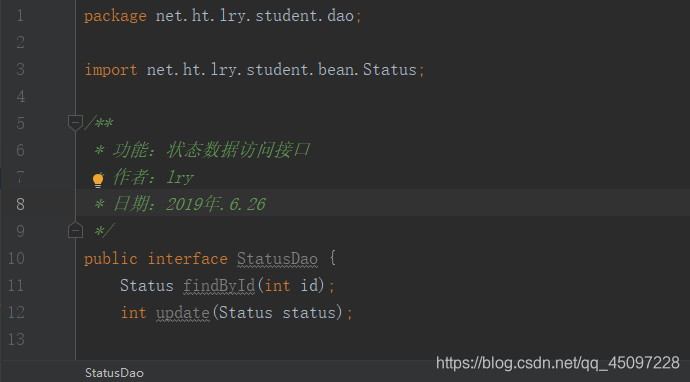
3、在net.姓名.student下创建dao包,再创建StudentDao,如下图:

4、在net.姓名.student下创建dao包,再创建UserDao,如下图: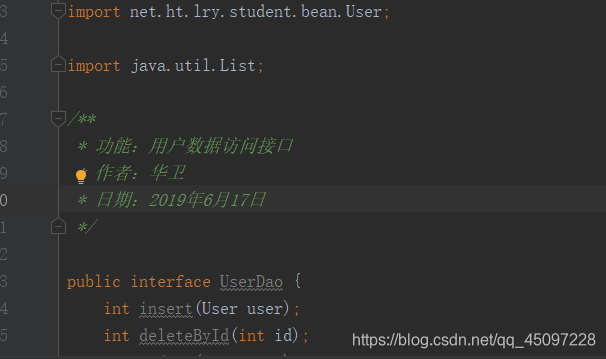
5、在dao子包里创建impl子包,然后在里面创建四个数据访问接口的实现类。
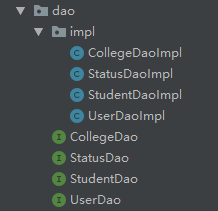
6、在根包net.hw.student里创建test子包,在里面创建测试类TestCollegeDaoImpl:
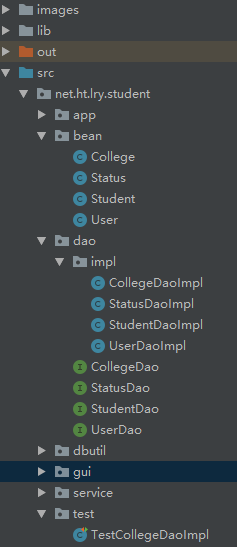
输入完整代码:
package net.ht.lry.student.dao.impl;
import net.ht.lry.student.bean.College;
import net.ht.lry.student.dao.CollegeDao;
import net.ht.lry.student.dbutil.ConnectionManager;
import java.sql.*;
/**
-
功能:学校数据访问接口实现类
-
作者:lry
-
日期:2019.6.26
/
public class CollegeDaoImpl implements CollegeDao {
/*-
按id查找学校
-
@param id
-
@return 学校对象
*/
@Override
public College findById(int id) {
// 声明学校对象
College college = null;// 1. 获取数据库连接
Connection conn = ConnectionManager.getConnection();
// 2. 定义SQL字符串
String strSQL = “select * from t_college where id = ?”;
try {
// 3. 创建预备语句对象
PreparedStatement pstmt = conn.prepareStatement(strSQL);
// 4. 设置占位符的值
pstmt.setInt(1, id);
// 5. 执行SQL,返回结果集
ResultSet rs = pstmt.executeQuery();
// 6. 判断结果集是否有记录
if (rs.next()) {
// 实例化学校对象
college = new College();
// 利用当前记录字段值去设置学校对象的属性
college.setId(rs.getInt(“id”));
college.setName(rs.getString(“name”));
college.setPresident(rs.getString(“president”));
college.setStartTime(rs.getDate(“start_time”));
college.setTelephone(rs.getString(“telephone”));
college.setEmail(rs.getString(“email”));
college.setAddress(rs.getString(“address”));
college.setProfile(rs.getString(“profile”));
}
// 7. 关闭预备语句对象
pstmt.close();
// 8. 关闭结果集对象
rs.close();
} catch (SQLException e) {
e.printStackTrace();
} finally {
// 关闭数据库连接
ConnectionManager.closeConnection(conn);
}// 返回学校对象
return college;
}
/**
-
更新学校信息
-
@param college
-
@return 更新记录数
*/
@Override
public int update(College college) {
// 定义更新记录数
int count = 0;// 1. 获取数据库连接
Connection conn = ConnectionManager.getConnection();
// 2. 定义SQL字符串
String strSQL = “update t_college set name = ?, president = ?, start_time = ?,”
+ " telephone = ?, email = ?, address = ?, profile = ? where id = ?";
try {
// 3. 创建预备语句对象
PreparedStatement pstmt = conn.prepareStatement(strSQL);
// 4. 设置占位符的值
pstmt.setString(1, college.getName());
pstmt.setString(2, college.getPresident());
pstmt.setTimestamp(3, new Timestamp(college.getStartTime().getTime()));
pstmt.setString(4, college.getTelephone());
pstmt.setString(5, college.getEmail());
pstmt.setString(6, college.getAddress());
pstmt.setString(7, college.getProfile());
pstmt.setInt(8, college.getId());
// 5. 执行SQL,返回更新记录数
count = pstmt.executeUpdate();
// 6. 关闭预备语句对象
pstmt.close();
} catch (SQLException e) {
e.printStackTrace();
} finally {
// 关闭数据库连接
ConnectionManager.closeConnection(conn);
}// 返回更新记录数
return count;
}
}
-
7、状态数据访问接口实现类StatusDaoImpl
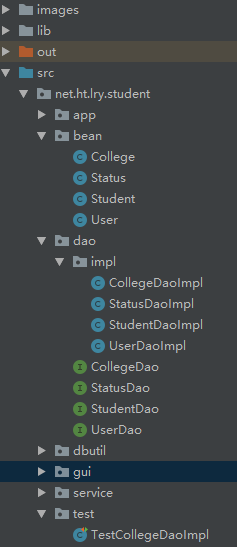
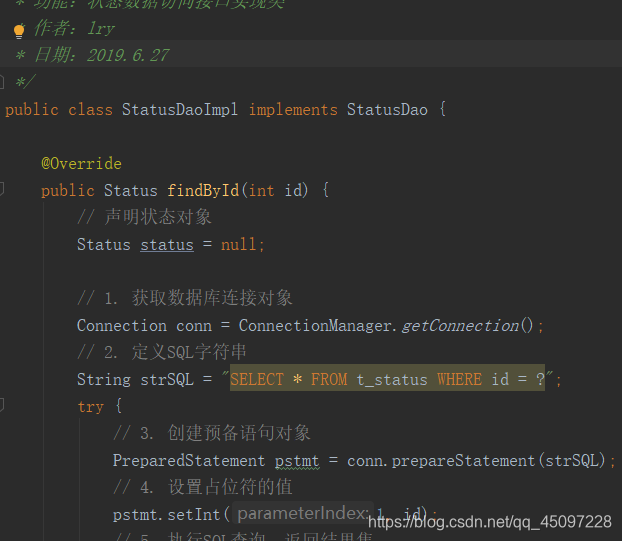
输入完整代码:
package net.ht.lry.student.dao.impl;
import net.ht.lry.student.bean.Status;
import net.ht.lry.student.dao.StatusDao;
import net.ht.lry.student.dbutil.ConnectionManager;
import java.sql.Connection;
import java.sql.PreparedStatement;
import java.sql.ResultSet;
import java.sql.SQLException;
/**
-
功能:状态数据访问接口实现类
-
作者:lry
-
日期:2019.6.27
*/
public class StatusDaoImpl implements StatusDao {@Override
public Status findById(int id) {
// 声明状态对象
Status status = null;
// 1. 获取数据库连接对象
Connection conn = ConnectionManager.getConnection();
// 2. 定义SQL字符串
String strSQL = “SELECT * FROM t_status WHERE id = ?”;
try {
// 3. 创建预备语句对象
PreparedStatement pstmt = conn.prepareStatement(strSQL);
// 4. 设置占位符的值
pstmt.setInt(1, id);
// 5. 执行SQL查询,返回结果集
ResultSet rs = pstmt.executeQuery();
// 6. 判断结果集是否有记录
if (rs.next()) {
// 实例化状态
status = new Status();
// 利用当前记录字段值去设置状态对象的属性
status.setId(rs.getInt(“id”));
status.setCollege(rs.getString(“college”));
status.setVersion(rs.getString(“version”));
status.setAuthor(rs.getString(“author”));
status.setTelephone(rs.getString(“telephone”));
status.setAddress(rs.getString(“address”));
status.setEmail(rs.getString(“email”));
}
// 7. 关闭预备语句对象
pstmt.close();
// 8. 关闭结果集对象
rs.close();
} catch (SQLException e) {
e.printStackTrace();
} finally {
// 关闭数据库连接
ConnectionManager.closeConnection(conn);
}
// 返回状态对象
return status;
}
@Override
public int update(Status status) {
// 定义更新记录数
int count = 0;
// 1. 获得数据库连接
Connection conn = ConnectionManager.getConnection();
// 2. 定义SQL字符串
String strSQL = “UPDATE t_status SET college = ?, version = ?, author = ?,”
+ " telephone = ?, address = ?, email = ? WHERE id = ?";
try {
// 3. 创建预备语句对象
PreparedStatement pstmt = conn.prepareStatement(strSQL);
// 4. 设置占位符的值
pstmt.setString(1, status.getCollege());
pstmt.setString(2, status.getVersion());
pstmt.setString(3, status.getAuthor());
pstmt.setString(4, status.getTelephone());
pstmt.setString(5, status.getAddress());
pstmt.setString(6, status.getEmail());
pstmt.setInt(7, status.getId());
// 5. 执行更新操作,更新记录
count = pstmt.executeUpdate();
// 6. 关闭预备语句对象
pstmt.close();
} catch (SQLException e) {
e.printStackTrace();
} finally {
// 关闭数据库连接
ConnectionManager.closeConnection(conn);
}
// 返回更新记录数
return count;
}
}







 本文详细介绍了一个基于Java的数据库操作案例,包括学校和状态信息的数据访问接口实现,通过具体代码展示了如何进行数据查询和更新。
本文详细介绍了一个基于Java的数据库操作案例,包括学校和状态信息的数据访问接口实现,通过具体代码展示了如何进行数据查询和更新。
















 6420
6420

 被折叠的 条评论
为什么被折叠?
被折叠的 条评论
为什么被折叠?








